Jongmin Park
Toward High Accuracy DME for Alternative Aircraft Positioning: SFOL Pulse Transmission in High-Power DME
Jun 07, 2025Abstract:The Stretched-FrOnt-Leg (SFOL) pulse is an advanced distance measuring equipment (DME) pulse that offers superior ranging accuracy compared to conventional Gaussian pulses. Successful SFOL pulse transmission has been recently demonstrated from a commercial Gaussian pulse-based DME in low-power mode utilizing digital predistortion (DPD) techniques for power amplifiers. These adjustments were achieved through software modifications, enabling SFOL integration without replacing existing DME infrastructure. However, the SFOL pulse is designed to optimize ranging capabilities by leveraging the effective radiated power (ERP) and pulse shape parameters permitted within DME specifications. Consequently, it operates with narrow margins against these specifications, potentially leading to non-compliance when transmitted in high-power mode. This paper introduces strategies to enable a Gaussian pulse-based DME to transmit the SFOL pulse while adhering to DME specifications in high-power mode. The proposed strategies involve use of a variant of the SFOL pulse and DPD techniques utilizing truncated singular value decomposition, tailored for high-power DME operations. Test results, conducted on a testbed utilizing a commercial Gaussian pulse-based DME, demonstrate the effectiveness of these strategies, ensuring compliance with DME specifications in high-power mode with minimal performance loss. This study enables cost-effective integration of high-accuracy SFOL pulses into existing high-power DME systems, enhancing aircraft positioning precision while ensuring compliance with industry standards.
MoBGS: Motion Deblurring Dynamic 3D Gaussian Splatting for Blurry Monocular Video
Apr 21, 2025Abstract:We present MoBGS, a novel deblurring dynamic 3D Gaussian Splatting (3DGS) framework capable of reconstructing sharp and high-quality novel spatio-temporal views from blurry monocular videos in an end-to-end manner. Existing dynamic novel view synthesis (NVS) methods are highly sensitive to motion blur in casually captured videos, resulting in significant degradation of rendering quality. While recent approaches address motion-blurred inputs for NVS, they primarily focus on static scene reconstruction and lack dedicated motion modeling for dynamic objects. To overcome these limitations, our MoBGS introduces a novel Blur-adaptive Latent Camera Estimation (BLCE) method for effective latent camera trajectory estimation, improving global camera motion deblurring. In addition, we propose a physically-inspired Latent Camera-induced Exposure Estimation (LCEE) method to ensure consistent deblurring of both global camera and local object motion. Our MoBGS framework ensures the temporal consistency of unseen latent timestamps and robust motion decomposition of static and dynamic regions. Extensive experiments on the Stereo Blur dataset and real-world blurry videos show that our MoBGS significantly outperforms the very recent advanced methods (DyBluRF and Deblur4DGS), achieving state-of-the-art performance for dynamic NVS under motion blur.
SplineGS: Robust Motion-Adaptive Spline for Real-Time Dynamic 3D Gaussians from Monocular Video
Dec 13, 2024



Abstract:Synthesizing novel views from in-the-wild monocular videos is challenging due to scene dynamics and the lack of multi-view cues. To address this, we propose SplineGS, a COLMAP-free dynamic 3D Gaussian Splatting (3DGS) framework for high-quality reconstruction and fast rendering from monocular videos. At its core is a novel Motion-Adaptive Spline (MAS) method, which represents continuous dynamic 3D Gaussian trajectories using cubic Hermite splines with a small number of control points. For MAS, we introduce a Motion-Adaptive Control points Pruning (MACP) method to model the deformation of each dynamic 3D Gaussian across varying motions, progressively pruning control points while maintaining dynamic modeling integrity. Additionally, we present a joint optimization strategy for camera parameter estimation and 3D Gaussian attributes, leveraging photometric and geometric consistency. This eliminates the need for Structure-from-Motion preprocessing and enhances SplineGS's robustness in real-world conditions. Experiments show that SplineGS significantly outperforms state-of-the-art methods in novel view synthesis quality for dynamic scenes from monocular videos, achieving thousands times faster rendering speed.
Multi-Hyperbolic Space-based Heterogeneous Graph Attention Network
Nov 18, 2024Abstract:To leverage the complex structures within heterogeneous graphs, recent studies on heterogeneous graph embedding use a hyperbolic space, characterized by a constant negative curvature and exponentially increasing space, which aligns with the structural properties of heterogeneous graphs. However, despite heterogeneous graphs inherently possessing diverse power-law structures, most hyperbolic heterogeneous graph embedding models use a single hyperbolic space for the entire heterogeneous graph, which may not effectively capture the diverse power-law structures within the heterogeneous graph. To address this limitation, we propose Multi-hyperbolic Space-based heterogeneous Graph Attention Network (MSGAT), which uses multiple hyperbolic spaces to effectively capture diverse power-law structures within heterogeneous graphs. We conduct comprehensive experiments to evaluate the effectiveness of MSGAT. The experimental results demonstrate that MSGAT outperforms state-of-the-art baselines in various graph machine learning tasks, effectively capturing the complex structures of heterogeneous graphs.
Hyperbolic Heterogeneous Graph Attention Networks
Apr 15, 2024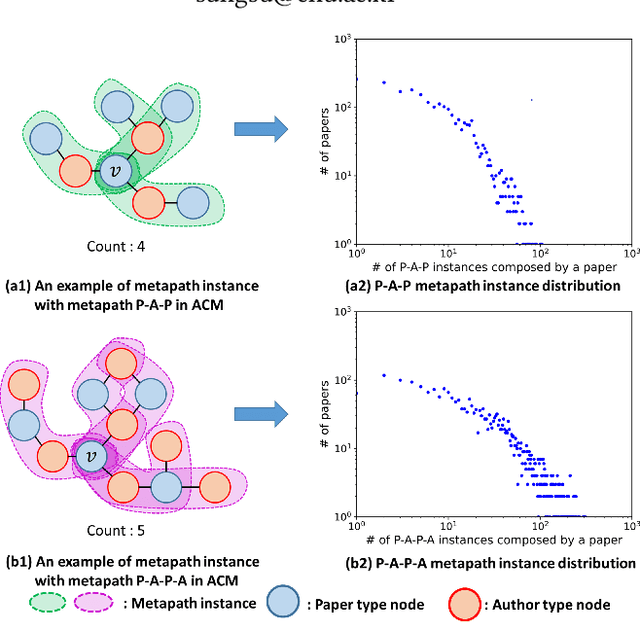
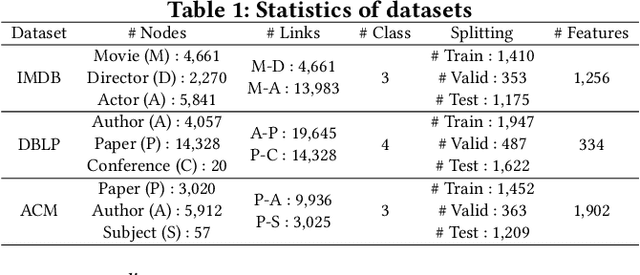
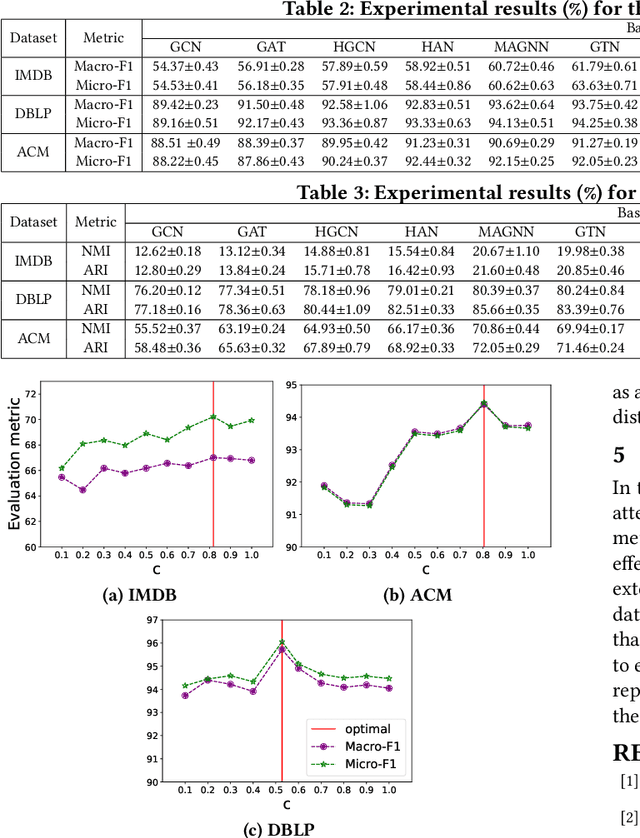
Abstract:Most previous heterogeneous graph embedding models represent elements in a heterogeneous graph as vector representations in a low-dimensional Euclidean space. However, because heterogeneous graphs inherently possess complex structures, such as hierarchical or power-law structures, distortions can occur when representing them in Euclidean space. To overcome this limitation, we propose Hyperbolic Heterogeneous Graph Attention Networks (HHGAT) that learn vector representations in hyperbolic spaces with meta-path instances. We conducted experiments on three real-world heterogeneous graph datasets, demonstrating that HHGAT outperforms state-of-the-art heterogeneous graph embedding models in node classification and clustering tasks.
DyBluRF: Dynamic Deblurring Neural Radiance Fields for Blurry Monocular Video
Dec 21, 2023



Abstract:Video view synthesis, allowing for the creation of visually appealing frames from arbitrary viewpoints and times, offers immersive viewing experiences. Neural radiance fields, particularly NeRF, initially developed for static scenes, have spurred the creation of various methods for video view synthesis. However, the challenge for video view synthesis arises from motion blur, a consequence of object or camera movement during exposure, which hinders the precise synthesis of sharp spatio-temporal views. In response, we propose a novel dynamic deblurring NeRF framework for blurry monocular video, called DyBluRF, consisting of an Interleave Ray Refinement (IRR) stage and a Motion Decomposition-based Deblurring (MDD) stage. Our DyBluRF is the first that addresses and handles the novel view synthesis for blurry monocular video. The IRR stage jointly reconstructs dynamic 3D scenes and refines the inaccurate camera pose information to combat imprecise pose information extracted from the given blurry frames. The MDD stage is a novel incremental latent sharp-rays prediction (ILSP) approach for the blurry monocular video frames by decomposing the latent sharp rays into global camera motion and local object motion components. Extensive experimental results demonstrate that our DyBluRF outperforms qualitatively and quantitatively the very recent state-of-the-art methods. Our project page including source codes and pretrained model are publicly available at https://kaist-viclab.github.io/dyblurf-site/.
COMPASS: High-Efficiency Deep Image Compression with Arbitrary-scale Spatial Scalability
Sep 11, 2023Abstract:Recently, neural network (NN)-based image compression studies have actively been made and has shown impressive performance in comparison to traditional methods. However, most of the works have focused on non-scalable image compression (single-layer coding) while spatially scalable image compression has drawn less attention although it has many applications. In this paper, we propose a novel NN-based spatially scalable image compression method, called COMPASS, which supports arbitrary-scale spatial scalability. Our proposed COMPASS has a very flexible structure where the number of layers and their respective scale factors can be arbitrarily determined during inference. To reduce the spatial redundancy between adjacent layers for arbitrary scale factors, our COMPASS adopts an inter-layer arbitrary scale prediction method, called LIFF, based on implicit neural representation. We propose a combined RD loss function to effectively train multiple layers. Experimental results show that our COMPASS achieves BD-rate gain of -58.33% and -47.17% at maximum compared to SHVC and the state-of-the-art NN-based spatially scalable image compression method, respectively, for various combinations of scale factors. Our COMPASS also shows comparable or even better coding efficiency than the single-layer coding for various scale factors.
Accurate Open-set Recognition for Memory Workload
Dec 17, 2022Abstract:How can we accurately identify new memory workloads while classifying known memory workloads? Verifying DRAM (Dynamic Random Access Memory) using various workloads is an important task to guarantee the quality of DRAM. A crucial component in the process is open-set recognition which aims to detect new workloads not seen in the training phase. Despite its importance, however, existing open-set recognition methods are unsatisfactory in terms of accuracy since they fail to exploit the characteristics of workload sequences. In this paper, we propose Acorn, an accurate open-set recognition method capturing the characteristics of workload sequences. Acorn extracts two types of feature vectors to capture sequential patterns and spatial locality patterns in memory access. Acorn then uses the feature vectors to accurately classify a subsequence into one of the known classes or identify it as the unknown class. Experiments show that Acorn achieves state-of-the-art accuracy, giving up to 37% points higher unknown class detection accuracy while achieving comparable known class classification accuracy than existing methods.
Indoor Path Planning for Multiple Unmanned Aerial Vehicles via Curriculum Learning
Sep 05, 2022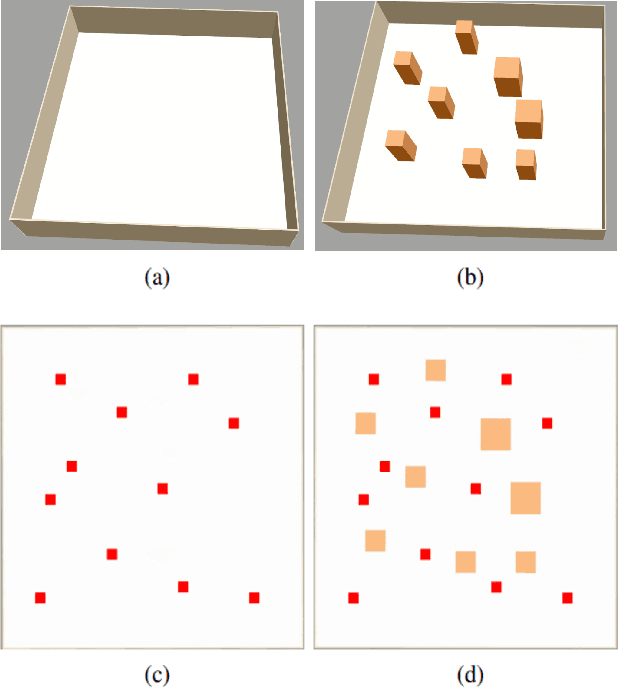
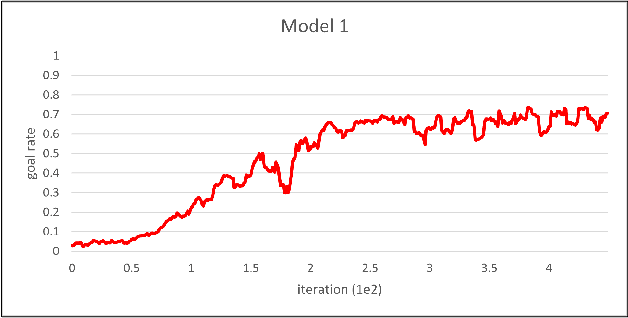
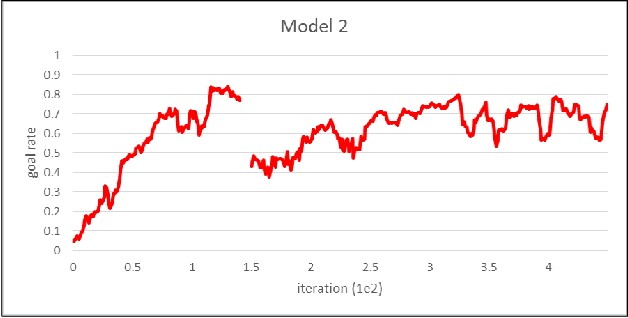
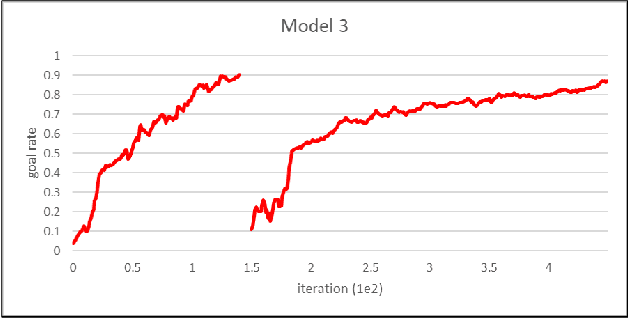
Abstract:Multi-agent reinforcement learning was performed in this study for indoor path planning of two unmanned aerial vehicles (UAVs). Each UAV performed the task of moving as fast as possible from a randomly paired initial position to a goal position in an environment with obstacles. To minimize training time and prevent the damage of UAVs, learning was performed by simulation. Considering the non-stationary characteristics of the multi-agent environment wherein the optimal behavior varies based on the actions of other agents, the action of the other UAV was also included in the state space of each UAV. Curriculum learning was performed in two stages to increase learning efficiency. A goal rate of 89.0% was obtained compared with other learning strategies that obtained goal rates of 73.6% and 79.9%.
Indoor Path Planning for an Unmanned Aerial Vehicle via Curriculum Learning
Aug 23, 2021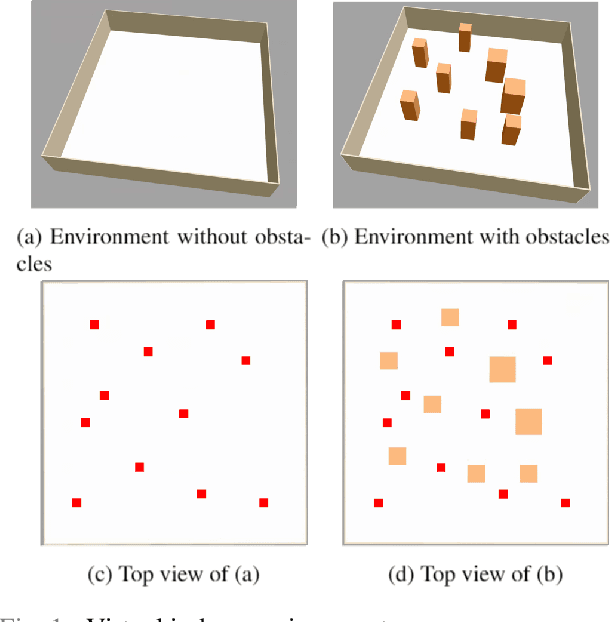
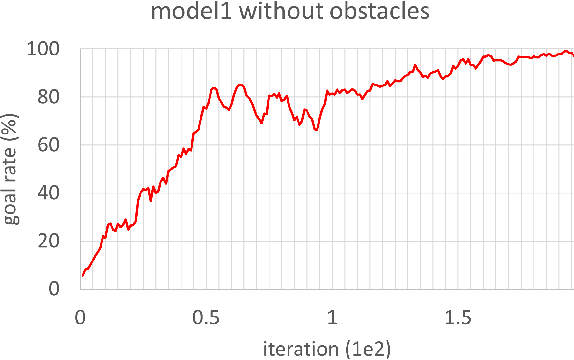
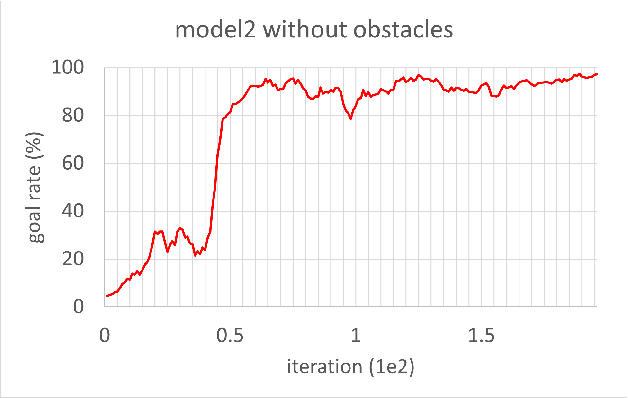
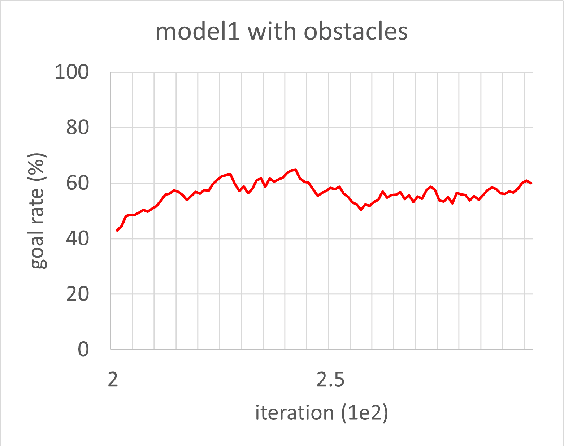
Abstract:In this study, reinforcement learning was applied to learning two-dimensional path planning including obstacle avoidance by unmanned aerial vehicle (UAV) in an indoor environment. The task assigned to the UAV was to reach the goal position in the shortest amount of time without colliding with any obstacles. Reinforcement learning was performed in a virtual environment created using Gazebo, a virtual environment simulator, to reduce the learning time and cost. Curriculum learning, which consists of two stages was performed for more efficient learning. As a result of learning with two reward models, the maximum goal rates achieved were 71.2% and 88.0%.
 Add to Chrome
Add to Chrome Add to Firefox
Add to Firefox Add to Edge
Add to Edge